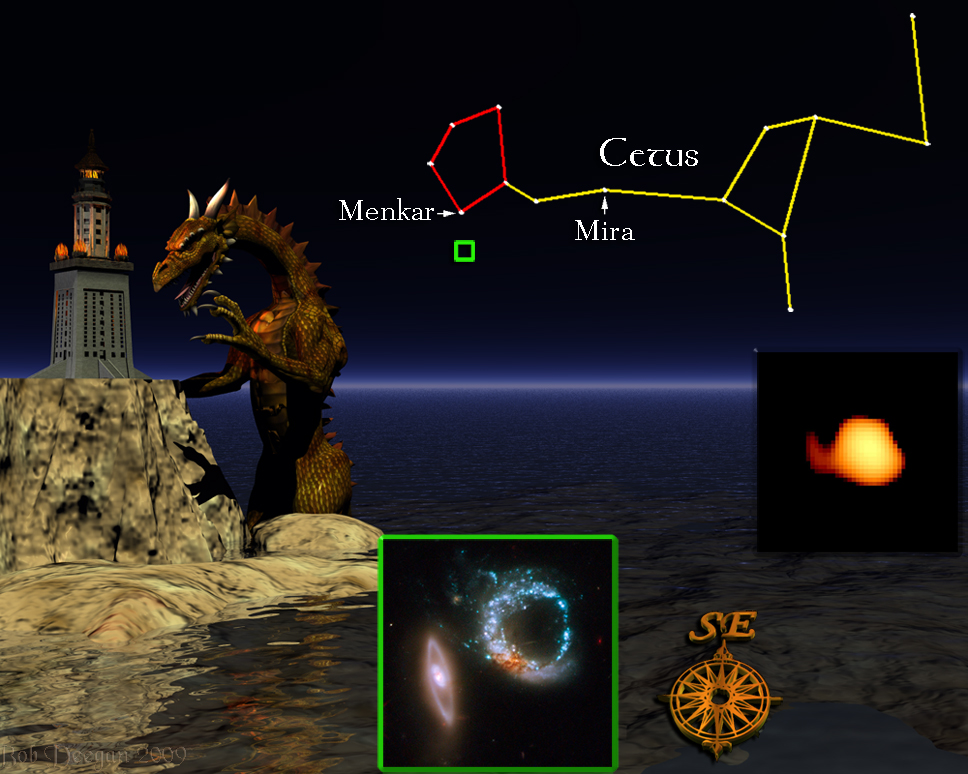
For the week including November 6, 2009

THE SEA MONSTER
This time of year, around 8pm, the constellation of Cetus, the Sea Monster, is just above the southeastern horizon. According to Greek myth, the sea monster was about to devour the beautiful princess Andromeda when it was slain by the hero Perseus. Of all the ancient legends, the story of Perseus and Andromeda is one of the most enduring. There are half a dozen constellations visible in the north and east that commemorate it in one way or another.
Although the stars of Cetus aren’t very prominent, a careful hunt will allow you to pick out the faint loop of stars (highlighted in red in our illustration) that marks the head of the Monster. The rest of Cetus spreads across the horizon to the southeast.
Hipparchus of ancient Greece told about a mysterious star in Cetus that would appear in the sky, grow brighter over months and then slowly fade away. Stars like this had been seen before and each was called a nova, signifying that their sudden appearance distinguished them as “new”. The strange star that Hipparchus saw was different; its disappearance was always followed by a gradual reappearance. More than a thousand years later, Chinese and Korean astronomers noted the unusual star as well.
In 1596, David Fabricius of the Netherlands accidently came across the odd star and noted that within a month it had brightened tremendously. In 1603, the star, now labeled omicron Ceti was included as a fairly bright member of Johann Bayer’s star atlas, the best sky map that had yet been produced. When Galileo popularized the use of a Dutch invention that he called the telescope in 1610, astronomers began to plot the star’s comings and goings. Every reappearance of the curious star has been recorded since 1638. In 1662, Johann Hevelius wrote about it in his Historiola Mirae Stellae (A Short History of a Wonderful Star) and it finally got a name – Mira, the Wonderful. At one of Mira’s peak luminosities in 1779, it nearly became the tenth brightest star in the heavens and glowed a deep garnet red.
We know now that Mira is a huge star, the tenth largest known and 400 times larger than our Sun. It is the prototype of a class of stars called “Pulsating Variables”. When irregular nuclear reactions accelerate within Mira, it grows in size and brightness. As the reactions subside, Mira shrinks back and becomes dimmer. Mira’s brightness varies on a 332-day cycle and at times there is a considerable difference in its peak luminosity.
In 1995, the Hubble Space Telescope was turned to Mira and the resulting images didn’t disappoint anyone. Mira has an oblong shape and is part of a binary star system, a fact once posited by Alfred Joy of California’s Mount Wilson Observatory in the 1920s. Its white dwarf partner orbits Mira at distance equivalent to seventy times the separation of the Earth and Sun. The image at the right in our illustration shows a hook of material extending from Mira toward its companion star.
For the amateur astronomer, there are other wonderful things in this constellation:
If you have a telescope, turn it on the orange giant star, Menkar, the brightest star in the Loop. Very close by is a blue-white star that provides a striking color contrast.
The “10” (shown at lower center): In a strong backyard telescope, it’s a bit of a shock to see a ghostly “10” floating among the stars. The interacting galaxies of Arp 147 are about 400 million light years away. Mutual gravitational attraction has formed ring structures in both galaxies and intense star generation is notable in the bright blue sections of the “zero”.
Unless otherwise indicated, all content of this web site is the copyright of Robert Deegan and all rights are reserved.
For more information, or to comment, please contact: Bob@NightSkies.org